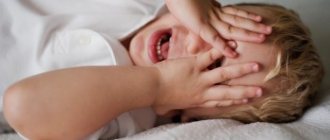The prevalence of generalized anxiety disorder (GAD) is 6%. The median age of onset was 31 years, and the mean age of onset was 32.7 years. Prevalence in children is 3%, in adolescents – 10.8%. The age of onset of the disease in children and adolescents is between 10 and 14. There is evidence that GAD is 2-3 times more common in women than in men, and that GAD is more common in older people. This disorder often goes unrecognized and less than a third of patients receive adequate treatment. The situation is complicated by the fact that it may be necessary to separate GAD in children from GAD in adults.
GAD is associated with functional impairment and decreased quality of life. When initially visiting a doctor, 60-94% of patients with GAD complain of painful physical symptoms and in 72% of cases this is the reason for seeking medical help.
We present to your attention a review translation of clinical guidelines for the treatment of generalized anxiety disorder, compiled by experts from the Canadian Anxiety Disorders Association. The translation was prepared jointly by the scientific Internet portal “Psychiatry & Neuroscience” and the Psychiatry Clinic “Doctor SAN” (St. Petersburg).
Diagnosis
GAD is characterized by increased anxiety and worry (most days during the past six months) about a variety of events and activities, such as school or work. In addition, GAD is associated with restlessness, muscle tension, fatigue, problems concentrating, irritability and sleep disturbances.
DSM-5 criteria for diagnosing GAD
- Excessive anxiety and worry (anxious anticipation) about a variety of events and activities, such as school or work.
- The person has difficulty gaining control over anxiety
- Excessive anxiety and worry are associated with at least three of the following symptoms, affecting a person most days for at least six months: Restlessness or feeling on edge, fatigue, difficulty concentrating, irritability, muscle tension or sleep disturbances
Symptoms of Anxiety Disorder
The symptoms of the disease are extremely extensive. Depending on the type of anxiety symptoms, according to ICD-10, the following symptoms are distinguished:
For anxiety-phobic adaptation disorders, the following are distinguished:
- Obsessive-compulsive disorder;
- Panic disorder;
- Post-traumatic stress disorder.
- Anxiety-phobic disorder:
- Reaction to acute systematic stress;
- Obsessive-compulsive disorders;
- Anxiety-depressive disorder;
- Generalized anxiety disorder;
- Panic disorder.
Panic disorder. The main symptom is panic attacks, which are periodically repeated, appearing in the form of discomfort and sudden fear. Symptoms of this condition are the following: fear of death, fear of becoming crazy, increased sweating, trembling, chest pain, shortness of breath, suffocation, rapid heartbeat, dizziness. Panic attacks usually last around 10-20 minutes. Patients often think they are having a heart attack.
Each subsequent attack intensifies fears and anxieties, to which another fear is also added - the fear of the next attack. Patients are more afraid not of the attack itself, but of the fact that it will happen at the wrong time or in places where it will be difficult for them to provide help. For this reason, patients begin to go around places with large crowds of people and completely deserted places. They stop walking alone and try not to leave the house at all. This phenomenon, which significantly reduces the quality of life, is known to science as Agoraphobia.
Some patients experience difficulties with anxiety disorders for many years of life due to constant relapses. Others manage to cope with the disease on their own - suddenly and spontaneously. There is also a third group of people who succumb to panic disorders and become couch potatoes, and this conditional status remains with them for several years.
Generalized anxiety disorders are characterized by a unique feature. This type of disease causes anxiety, which is not associated with any circumstances: situations, place of stay, and so on. Seizures are non-fixed and occur at any time and anywhere.
A diagnosis of anxiety disorder is made only when the symptoms of the disease have plagued the patient for at least 2-3 weeks. The most popular symptoms are:
- Fussiness, trembling, headaches, inability to relax and other types of motor tension;
- Difficulty concentrating, constant worry, worries about potential failures and other concerns;
- Dry mouth, epigastric discomfort, tachypnea, tachycardia, sweating, dizziness and other manifestations of autonomic hyperactivity.
Experts begin to talk about mixed anxiety and depressive disorders in cases where depression and anxiety are inherent in the patient, but they are moderately pronounced - not pronounced enough to determine a diagnosis.
In these conditions, diagnosis is quite problematic due to insufficiently expressed symptoms. The diagnosis of panic disorder is made in this case, rather, by exclusion. In generalized anxiety disorder, the symptoms are mild to moderate in intensity and the anxiety is vague but persistent. This is the main difference between this disease and panic disorders, in which attacks of excessively high intensity occur.
Generalized anxiety disorder is also called “free-floating.” This is explained by internal tension, a feeling of threat or potential misfortune that arises as a result of certain situations and conflicts of minor magnitude. In the eyes of patients, these situations have increasingly dire consequences; patients begin to consider all problems unsolvable. Often, in addition to anxiety, excessive aggressiveness appears. This disease negatively affects the musculoskeletal and autonomic-endocrine systems.
Most researchers agree that generalized anxiety disorder is not an independent disease, but rather a certain phenomenon of anxiety expressed in other diseases. For example, in its manifestation this disorder resembles anticipatory anxiety, which is a hallmark of panic disorder. However, unlike the same panic disorders, vegetative manifestations are involved to a lesser extent, while the prognosis of generalized anxiety disorder is more optimistic, and the disease itself begins more smoothly, gradually. As for the symptoms, they are not clonic, as in panic disorders, but tonic. Despite these differences between the two types of disease, the first disease can lead to the second, and the second to the first.
Social phobia is one of the manifestations of anxiety disorders. This phobia is expressed in excessive fear of experiencing embarrassment or humiliation in front of others, even strangers. This forces patients to avoid establishments where groups of people gather, as well as public speaking, being in large companies, and so on. As a rule, social phobia implies significant limitations in the patient’s life activities, and this often leads the patient to the next stage – Agoraphobia.
A simple phobia is expressed by excessive fear of specific situations, objects, creatures, and so on. There are a lot of examples of phobias: fear of heights, pets, snakes, airplanes, elevators, and so on. When meeting an object of fear, the patient always experiences trembling, horror, heart rate increases and sweating increases.
Obsessive-compulsive disorder is a combination of compulsivity and obsession (obsession). The latter is characterized by persistent impulses, thoughts or ideas, usually perceived as meaningless. For example, the thought of selling T-shirts, blasphemous thoughts, and so on. Patients realize the meaninglessness of these thoughts, but are unable to cope with this internal zeal. As for compulsivity, it is rather a reaction to obsessive thoughts that have arisen, aimed at neutralizing them and, accordingly, achieving psychological comfort. However, this behavior is senseless, and at the same time absolutely unreasonable.
Obsessive-compulsive disorders have several types. The most common is known as fear of dirt. Thoughts on the topic of pollution lead to the fact that patients try to stay in the cleanest possible places, and spend almost 2-3 hours a day washing. Another fairly popular type of obsessive-compulsive disorder is compulsive checking. Patients always check several times whether the iron, gas is turned off, whether the door is closed, and so on. In general, compulsive behavior is somewhat reminiscent of excesses in eating, drinking, increased sexuality, and gambling, but in the case of this disease, the thoughts and behavioral characteristics that arise are always unpleasant for the patient.
Post-traumatic stress is an illness that occurs after car accidents, rape, beatings, after war and other severe physical or psychological trauma. Patients, as a rule, repeatedly experience what happened, replaying the unfavorable situation in their heads. Memories can appear both in everyday activities and at night in the form of nightmares. The patient experiences mental numbness, becomes passive, does not experience positive emotions, and loses interest in work and hobbies. Also, post-traumatic stress leads to overexcitation, which is expressed by excessive fearfulness, nightmares, and insomnia.
Post-traumatic stress disorders are divided into three groups depending on severity. The first stage is a completely adequate reaction to trauma, which is expressed in maximum concentration on what happened. The patient is overcome with anxiety. The second degree occurs approximately a month after the incident, if the person is still haunted by memories of what happened. At this stage, nightmares intensify, emotionality practically does not appear, and the feeling of helplessness continues to grow. The third and final stage is loss of spirit and complete demoralization, loss of the meaning of life, despair.
With anxiety disorders, patients focus as much as possible on their shortcomings and cannot adequately form an assessment of themselves. As a result, people become withdrawn and insecure, and they start new acquaintances and relationships only when they know for sure that they will not be rejected. Rejection, as well as the loss of an existing person, is a strong moral blow for patients, so they prefer not to take risks and do not particularly establish relationships with people. However, loneliness is not an option!
The symptoms of anxiety disorders are multifaceted and varied. The main symptoms of the disease include:
- Avoidance of relationships with new people;
- Desire for relationships with society, bordering on extreme shyness;
- Self-isolation from society;
- High sensitivity to refusals and criticism;
- Disgust for one's own person;
- Extremely low self-esteem;
- Feeling of one's own inferiority;
- Desire to avoid physical contact;
- Shyness and embarrassment can be caused by the slightest preconditions;
- Lack of desire for intimacy;
- Timidity, modesty within unreasonable limits;
- Trust only yourself;
- Excessive self-criticism;
- Feeling of loneliness;
- Feeling of inferiority compared to other people;
- Chemical and mental dependence.
Psychological help
Meta-analyses clearly show that CBT significantly reduces GAD symptoms. A small number of studies have compared the effects of CBT and pharmacotherapy, which have shown approximately the same effect size. Individual and group psychotherapy are equally effective in reducing anxiety, but individual psychotherapy may be more effective in reducing anxiety and depressive symptoms.
Psychotherapy intensity was assessed in a meta-analysis of 25 studies. For reducing anxiety, a course of psychotherapy lasting less than eight sessions is as effective as a course lasting more than eight sessions. In reducing anxiety and depression, more intensive courses are more effective than courses with a small number of sessions. Several studies have shown the benefits of ICBT.
The meta-analysis found no significant difference between the effects of CBT and relaxation therapy. However, more recent research suggests limited effectiveness of relaxation therapy. A large RCT found that balneotherapy, a relaxation therapy with spa treatments, was better than SSRIs in reducing anxiety; however, there are doubts about the validity of the study.
The effectiveness of behavioral psychotherapy based on acceptance, metacognitive psychotherapy, CBT aimed at correcting the perception of uncertainty, mindfulness-based cognitive therapy has been proven.
Psychodynamic psychotherapy can also provide results, but at the moment there is no clear evidence of its effectiveness.
Adding interpersonal and emotional-process therapy to CBT does not provide significant benefits compared to CBT without the addition. A preliminary conversation before starting a CBT course helps reduce resistance to therapy and improve compliance - this strategy is especially useful in severe cases.
Psychotherapeutic methods for treating neuroses
Any disorder always has its own objective cause. Neuroses are no exception. Psychotherapy is the tool that allows you to identify it and, with the help of a psychotherapist, find a way to eliminate it. This can be either an analysis of the situation that led to the disorder, or a subsequent change in attitude towards the stressor, a decrease in internal sensitivity to stressful situations and the development of skills to withstand them. Psychotherapy helps to find and use those internal tools that are inherent in each of us to maintain mental health and harmony. In our conditions, it is possible to conduct both individual therapy sessions and group classes, where it is easier to practice acquired skills. (We usually start with individual forms of work, and then, if the patient wants to work in a group, we supplement them with this form of treatment).
Combination of psychotherapy and pharmacological treatment
Few data are available on the use of combinations of psychotherapy and pharmacological treatment. A meta-analysis showed that the combination of pharmacological treatment with CBT was more effective than CBT alone when comparing results immediately after treatment, but not after six months. Data are available from studies comparing the combination of diazepam or buspirone plus CBT with CBT alone. The small number of studies comparing pharmacotherapy with pharmacotherapy plus psychotherapy has produced conflicting results.
There is currently no rationale for combining CBT with pharmacotherapy. But, as with other anxiety disorders, if the patient does not improve with CBT, the use of pharmacotherapy is recommended. Likewise, if pharmacotherapy does not improve, then CBT can be expected to help. Meta-analyses and several RCTs suggest that psychotherapy benefits are maintained 1-3 years after treatment.
What is Anxiety Disorder
A person experiences various anxieties throughout his life.
As a rule, they are a reaction to stressful situations occurring in everyday life, at work, and so on. However, we can talk about anxiety disorder as a disease only in cases where systematic anxiety significantly affects a person’s quality of life and forces him to adjust his lifestyle. Symptoms of anxiety disorders are extremely unique and depend on the type of disease. Today, there are generalized disorder and adaptive disorder, which has an alarming increase. Generalized anxiety disorder is characterized by constant excessive anxiety that envelops the patient in almost any situation, even the most mundane. In turn, people with adaptive anxiety disorder have difficulty adapting to stressful situations. Constant fear, worry, tension and anxiety in this disease can affect the functioning of various organs and systems: a person may be subject to rapid heartbeat, shortness of breath, a “nervous” stomach, and so on.
Pharmacological treatment
SSRIs, SSRIs, TCAs, benzodiazepines, pregabalin, quetiapine XR have been proven effective in the treatment of GAD.
First line
Antidepressants (SSRIs and SSRIs): RCTs show the effectiveness of escitalopram, sertraline and paroxetine, as well as duloxetine and venlafaxine XR. The effectiveness of SSRIs and SSRIs is the same. There is evidence that escitalopram is less effective than venlafaxine XR or quetiapine XR.
Other antidepressants: There is evidence that agomelatine is as effective as escitalopram.
Pregabalin: Pregabalin is as effective as benzodiazepines (level 1 evidence).
Second line
Benzodiazepines: Alprazolam, bromazepam, diazepam and lorazepam have been shown to be effective (level 1 evidence). Although the level of evidence is high, these drugs are recommended as second-line treatment and usually for short-term use due to side effects, dependence and withdrawal symptoms.
TCAs and other antidepressants: Imipramine is as effective as benzodiazepines in the treatment of GAD (level 1 evidence). But due to side effects and potentially toxic overdose, imipramine is recommended as a second-line treatment. There is little data on bupropion XL, but there is a study in which it was shown to be as effective as escitalopram (first-line agent), so it can be used as a second-line agent.
Vortioxetine, a so-called serotonin modulator, acts on different serotonin receptors. Research on the effectiveness of vortioxetine is inconsistent, but there is evidence to support its use for GAD.
Quetiapine XR: Quetiapine XR has proven efficacy and is equivalent to that of antidepressants. But quetiapine is associated with weight gain, sedation, and a higher rate of treatment discontinuation due to side effects than antidepressants. Because of problems associated with tolerability and safety of atypical antipsychotics, this drug is recommended as a second-line treatment for patients who cannot take antidepressants or benzodiazepines.
Other drugs: Buspirone has been shown to be as effective as benzodiazepines in several RCTs. There is insufficient data to compare buspirone with antidepressants. Due to its lack of effectiveness in clinical practice, buspirone should be classified as a second-line drug.
Hydroxyzine has shown efficacy close to that of benzodiazepines and buspirone, but there is insufficient clinical experience with the use of this drug for GAD.
Third line
Third-line drugs include drugs with poorly studied efficacy, side effects, and rarely used as a primary treatment for GAD.
Additional drugs
The adjunctive strategy has been studied in patients who have not responded adequately to SSRI treatment and may be used in cases of refractory GAD.
Second-line add-on drugs: Pregabalin, as an adjunct to the main drug, has been shown to be effective in treating patients who have not responded to previous treatment (level of evidence: 2).
Third-line add-on drugs: A meta-analysis showed no improvement with atypical antipsychotics as add-on drugs, but did show an increase in treatment failure. Studies of the effectiveness of risperidone and quetiapine as adjunctive agents show conflicting results.
Due to weak evidence of effectiveness, risk of weight gain, and metabolic side effects, atypical antipsychotics should be reserved for refractory cases of GAD and, with the exception of quetiapine XR, used only as an adjunct to the primary drug.
A drug | Level of evidence |
| SSRIs | |
| Escitalopram | 1 |
| Paroxetine | 1 |
| Sertraline | 1 |
| Fluoxetine | 3 |
| Citalopram | 3 |
| SSRI | |
| Duloxetine | 1 |
| Venlafaxine | 1 |
| TCA | |
| Imipramine | 1 |
| Other antidepressants | |
| Agomelatine | 1 |
| Vortioxetine | 1 (conflicting data) |
| Bupropion | 2 |
| Trazadone | 2 |
| Mirtazapine | 3 |
| Benzodiazepines | |
| Alprazolam | 1 |
| Bromazepam | 1 |
| Diazepam | 1 |
| Lorazepam | 1 |
| Anticonvulsants | |
| Pregabalin | 1 |
| Divalproex | 2 |
| Tiagabine | 1 (negative result) |
| Pregabalin as an adjunctive drug | 2 |
| Other drugs | |
| Buspirone | 1 |
| Hydroxyzine | 1 |
| Pexacerfont | 2 (negative result) |
| Propranolol | 2 (negative result) |
| Memantine | 4 (negative result) |
| Pindolol as an additive drug | 2 (negative result) |
| Atypical antipsychotics | |
| Quetiapine | 1 |
| Quetiapine as an add-on drug | 1 (conflicting data) |
| Risperidone as an add-on drug | 1 (conflicting data) |
| Olanzapine as an add-on drug | 2 |
| Aripiprazole as an add-on drug | 3 |
| Ziprasidone as monotherapy or in combination | 2 (negative result) |
| First line: Agomelatine, duloxetine, escitalopram, paroxetine, pregabalin, sertraline, venlafaxine Second line: Alprazolam*, bromazepam*, bupropion, buspirone, diazepam, hydroxyzine, imipramine, lorazepam*, quetiapine*, vortioxetine Third line: Citalopram, divalproex, fluoxetine, mirtazapine, trazodone Additional drugs (second line): Pregabalin Additional drugs (third line): Aripiprazole, olanzapine, quetiapine, risperidone Not recommended as adjunct drugs: Ziprasidone Not recommended: Beta blockers (propranolol), pexacefront, tiagabine *These drugs have their own mechanisms of action, effectiveness and safety profile. Benzodiazepines are best used as second-line drugs in most cases unless there is a risk of abuse; It is better to postpone bupropion XL for later. Quetiapine XR is a good choice in terms of effectiveness, but given the metabolic problems associated with atypical antipsychotics, it is best reserved for patients who cannot be prescribed antidepressants or benzodiazepines. |
Causes of Anxiety Disorder
The causes of anxiety disorders are explained by several theories from a biological and psychological point of view.
Biological theories. According to these theories, the disease is explained as a kind of biological anomaly caused by certain changes in the body. The most popular version of the occurrence of anxiety disorders is an increase in the production of neurotransmitters.
We should not exclude the possibility that it is the locus coeruleus that is responsible for the symptoms of the disease. It is located in the brain, namely in the stem part of it, and with electrical stimulation it becomes the cause of anxiety and fear. Medications that reduce the activity of the locus coeruleus and therefore reduce anxiety include propranolol, clonidine, and benzodiazepines. In turn, medications like yohimbine increase anxiety.
Psychological theories. From the point of view of psychoanalysis, anxiety is a manifestation that signals the presence of a forbidden need or a certain impulse that needs to be hidden and prevented from expressing the need. According to this theory, the symptoms of anxiety disorders are explained as containing an unacceptable need within oneself.
Phobias and anxieties in general, from the point of view of behaviorism, are considered as a reflex reaction to the sudden or expected appearance of frightening or painful stimuli. The brain gets used to this reaction and soon anxiety begins to arise regardless of whether there is a stimulus or not.
More recently, cognitive psychology has emphasized erroneous and distorted mental patterns that precede the onset of anxiety symptoms. For example, with anxiety disorders, patients may react in panic to seemingly standard sensations and ailments in everyday life (palpitations, mild headache). As a result, fear intensifies, and over time it grows and leads to a powerful panic attack. In domestic medicine, anxiety disorders are classified as a group of functional neuroses (a more modern name is neurotic disorders). According to the traditional classification, the disease is classified as psychogenic, which is characterized by awareness of the disease, a variety of symptoms and manifestations, as well as a complete absence of changes in consciousness.
Maintenance pharmacological therapy
A meta-analysis showed that long-term use of SSRIs (6–12 months) was effective in preventing relapse (odds ratio for relapse = 0.20).
Relapse after 6-18 months of duloxetine, escitalopram, paroxetine and venlayaxin XR was observed in 10-20% of cases, compared with 40-56% in the control group. Continuing pregabalin and quetiapine XR also prevents relapse after 6-12 months.
Long-term RCTs have shown that escitalopram, paroxetine and venlafaxine XR help maintain benefit over six months.
Application of instrumental therapy
In accordance with the examination results and the attending physician’s prescriptions, instrumental therapy is carried out:
- audio-visual stimulation method;
- light therapy;
- biofeedback (biofeedback) sessions;
- transcranial magnetic stimulation (TMS);
- intravenous laser blood irradiation (ILBI);
- “neural disk” is a computer treatment program that the patient, upon discharge from the hospital, can independently continue to use at home;
- massage.








